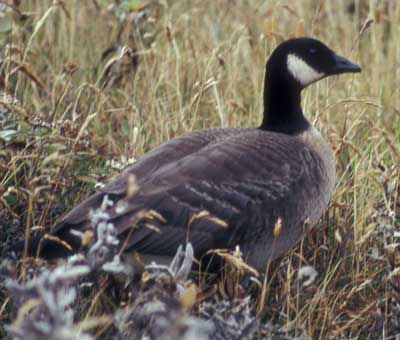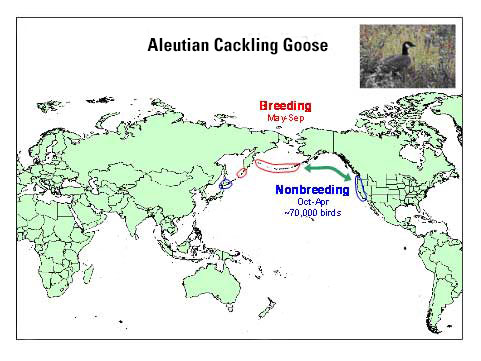Newest data (4/1/2008)
Approximate numbers of migrant birds that move between Asia and Alaska
<TABLE cellSpacing=0 cellPadding=5 border=1><TBODY><TR height=17><TD height=17> </TD><TD>Number</TD><TD>Percent of Total </TD></TR><TR height=17><TD height=17>Waterfowl</TD><TD align=right>561,000</TD><TD align=right>8.5%</TD></TR><TR height=17><TD height=17>Loons</TD><TD align=right>55,000</TD><TD align=right>0.8%</TD></TR><TR height=17><TD height=17>Shorebirds/Gulls</TD><TD align=right>1,226,000</TD><TD align=right>18.5%</TD></TR><TR height=17><TD height=17>Landbirds</TD><TD align=right>4,745,000</TD><TD align=right>71.8%</TD></TR><TR height=17><TD height=17>Raptors/Owls</TD><TD align=right>25,000</TD><TD align=right>0.4%</TD></TR><TR height=17><TD height=17>Totals</TD><TD align=right>6,612,000</TD><TD align=right>100%</TD></TR></TBODY></TABLE>
<TABLE cellSpacing=0 cellPadding=5 border=1><TBODY><TR><TD colSpan=2>Waterfowl</TD><TD colSpan=2>Shorebirds/Gulls</TD></TR><TR><TD>King eider</TD><TD align=right>200,000</TD><TD>Dunlin</TD><TD align=right>500,000</TD></TR><TR><TD>Brant</TD><TD align=right>10,000</TD><TD>Sharp-tailed sandpiper</TD><TD align=right>25,000</TD></TR><TR><TD>Steller's eider</TD><TD align=right>10,000</TD><TD>Bar-tailed godwit</TD><TD align=right>135,000</TD></TR><TR><TD>Emperor goose</TD><TD align=right>5,000</TD><TD>Ruddy turnstone</TD><TD align=right>15,000</TD></TR><TR><TD>Mallard</TD><TD align=right>100,000</TD><TD>Pectoral sandpiper</TD><TD align=right>200,000</TD></TR><TR><TD>Pintail</TD><TD align=right>100,000</TD><TD>Pacific golden-plover</TD><TD align=right>40,000</TD></TR><TR><TD>Eurasian widgeon</TD><TD align=right>1,000</TD><TD>Buff-breasted sandpiper</TD><TD align=right>3,000</TD></TR><TR><TD>Long-tailed duck</TD><TD align=right>100,000</TD><TD>Western sandpiper</TD><TD align=right>105,000</TD></TR><TR><TD>Red-breasted merganser</TD><TD align=right>10,000</TD><TD>Baird's sandpiper</TD><TD align=right>3,000</TD></TR><TR><TD>Harlequin duck</TD><TD align=right>20,000</TD><TD>Red knot</TD><TD align=right>37,500</TD></TR><TR><TD>Common eider</TD><TD align=right>5,000</TD><TD>Long-billed dowitcher</TD><TD align=right>125,000</TD></TR><TR><TD colSpan=2>Loons</TD><TD>Rock sandpiper</TD><TD align=right>12,500</TD></TR><TR><TD>Yellow-billed loon</TD><TD align=right>5,000</TD><TD>Aleutian tern</TD><TD align=right>10,000</TD></TR><TR><TD>Red-throated loon</TD><TD align=right>10,000</TD><TD>Glaucous gull</TD><TD align=right>10,000</TD></TR><TR><TD>Pacific loon</TD><TD align=right>40,000</TD><TD>Glaucous-winged gull</TD><TD align=right>5,000</TD></TR><TR><TD colSpan=2>Landbirds</TD><TD colSpan=2>Raptors/Owls</TD></TR><TR><TD>Arctic warbler</TD><TD align=right>2,700,000</TD><TD>Gyrfalcon</TD><TD align=right>5,000</TD></TR><TR><TD>Bluethroat</TD><TD align=right>100,000</TD><TD>Peregrin falcon</TD><TD align=right>5,000</TD></TR><TR><TD>White wagtail</TD><TD align=right>10,000</TD><TD>Snowy owl</TD><TD align=right>5,000</TD></TR><TR><TD>Eastern yellow wagtail</TD><TD align=right>1,400,000</TD><TD>Short-eared owl</TD><TD align=right>10,000</TD></TR><TR><TD>Northern wheatear</TD><TD align=right>300,000</TD><TD colSpan=2 rowSpan=5> </TD></TR><TR><TD>Red-throated pipit</TD><TD align=right>5,000</TD></TR><TR><TD>Redpoll species</TD><TD align=right>120,000</TD></TR><TR><TD>Lapland longspur</TD><TD align=right>100,000</TD></TR><TR><TD>Snow bunting</TD><TD align=right>10,000</TD></TR></TBODY></TABLE>
Approximate numbers of migrant birds that move between Asia and Alaska
<TABLE cellSpacing=0 cellPadding=5 border=1><TBODY><TR height=17><TD height=17> </TD><TD>Number</TD><TD>Percent of Total </TD></TR><TR height=17><TD height=17>Waterfowl</TD><TD align=right>561,000</TD><TD align=right>8.5%</TD></TR><TR height=17><TD height=17>Loons</TD><TD align=right>55,000</TD><TD align=right>0.8%</TD></TR><TR height=17><TD height=17>Shorebirds/Gulls</TD><TD align=right>1,226,000</TD><TD align=right>18.5%</TD></TR><TR height=17><TD height=17>Landbirds</TD><TD align=right>4,745,000</TD><TD align=right>71.8%</TD></TR><TR height=17><TD height=17>Raptors/Owls</TD><TD align=right>25,000</TD><TD align=right>0.4%</TD></TR><TR height=17><TD height=17>Totals</TD><TD align=right>6,612,000</TD><TD align=right>100%</TD></TR></TBODY></TABLE>
<TABLE cellSpacing=0 cellPadding=5 border=1><TBODY><TR><TD colSpan=2>Waterfowl</TD><TD colSpan=2>Shorebirds/Gulls</TD></TR><TR><TD>King eider</TD><TD align=right>200,000</TD><TD>Dunlin</TD><TD align=right>500,000</TD></TR><TR><TD>Brant</TD><TD align=right>10,000</TD><TD>Sharp-tailed sandpiper</TD><TD align=right>25,000</TD></TR><TR><TD>Steller's eider</TD><TD align=right>10,000</TD><TD>Bar-tailed godwit</TD><TD align=right>135,000</TD></TR><TR><TD>Emperor goose</TD><TD align=right>5,000</TD><TD>Ruddy turnstone</TD><TD align=right>15,000</TD></TR><TR><TD>Mallard</TD><TD align=right>100,000</TD><TD>Pectoral sandpiper</TD><TD align=right>200,000</TD></TR><TR><TD>Pintail</TD><TD align=right>100,000</TD><TD>Pacific golden-plover</TD><TD align=right>40,000</TD></TR><TR><TD>Eurasian widgeon</TD><TD align=right>1,000</TD><TD>Buff-breasted sandpiper</TD><TD align=right>3,000</TD></TR><TR><TD>Long-tailed duck</TD><TD align=right>100,000</TD><TD>Western sandpiper</TD><TD align=right>105,000</TD></TR><TR><TD>Red-breasted merganser</TD><TD align=right>10,000</TD><TD>Baird's sandpiper</TD><TD align=right>3,000</TD></TR><TR><TD>Harlequin duck</TD><TD align=right>20,000</TD><TD>Red knot</TD><TD align=right>37,500</TD></TR><TR><TD>Common eider</TD><TD align=right>5,000</TD><TD>Long-billed dowitcher</TD><TD align=right>125,000</TD></TR><TR><TD colSpan=2>Loons</TD><TD>Rock sandpiper</TD><TD align=right>12,500</TD></TR><TR><TD>Yellow-billed loon</TD><TD align=right>5,000</TD><TD>Aleutian tern</TD><TD align=right>10,000</TD></TR><TR><TD>Red-throated loon</TD><TD align=right>10,000</TD><TD>Glaucous gull</TD><TD align=right>10,000</TD></TR><TR><TD>Pacific loon</TD><TD align=right>40,000</TD><TD>Glaucous-winged gull</TD><TD align=right>5,000</TD></TR><TR><TD colSpan=2>Landbirds</TD><TD colSpan=2>Raptors/Owls</TD></TR><TR><TD>Arctic warbler</TD><TD align=right>2,700,000</TD><TD>Gyrfalcon</TD><TD align=right>5,000</TD></TR><TR><TD>Bluethroat</TD><TD align=right>100,000</TD><TD>Peregrin falcon</TD><TD align=right>5,000</TD></TR><TR><TD>White wagtail</TD><TD align=right>10,000</TD><TD>Snowy owl</TD><TD align=right>5,000</TD></TR><TR><TD>Eastern yellow wagtail</TD><TD align=right>1,400,000</TD><TD>Short-eared owl</TD><TD align=right>10,000</TD></TR><TR><TD>Northern wheatear</TD><TD align=right>300,000</TD><TD colSpan=2 rowSpan=5> </TD></TR><TR><TD>Red-throated pipit</TD><TD align=right>5,000</TD></TR><TR><TD>Redpoll species</TD><TD align=right>120,000</TD></TR><TR><TD>Lapland longspur</TD><TD align=right>100,000</TD></TR><TR><TD>Snow bunting</TD><TD align=right>10,000</TD></TR></TBODY></TABLE>
 Justification: A portion of the population of Aleutian Cackling Geese breeding on the Aleutian Islands may winter in Japan where they could possibly contract Asian H5N1, and the majority of geese breeding in the western Aleutians occupy islands visited by hundred of direct Asiatic migrant birds of a number of species directly from Asia annually.
Justification: A portion of the population of Aleutian Cackling Geese breeding on the Aleutian Islands may winter in Japan where they could possibly contract Asian H5N1, and the majority of geese breeding in the western Aleutians occupy islands visited by hundred of direct Asiatic migrant birds of a number of species directly from Asia annually. 

Comment